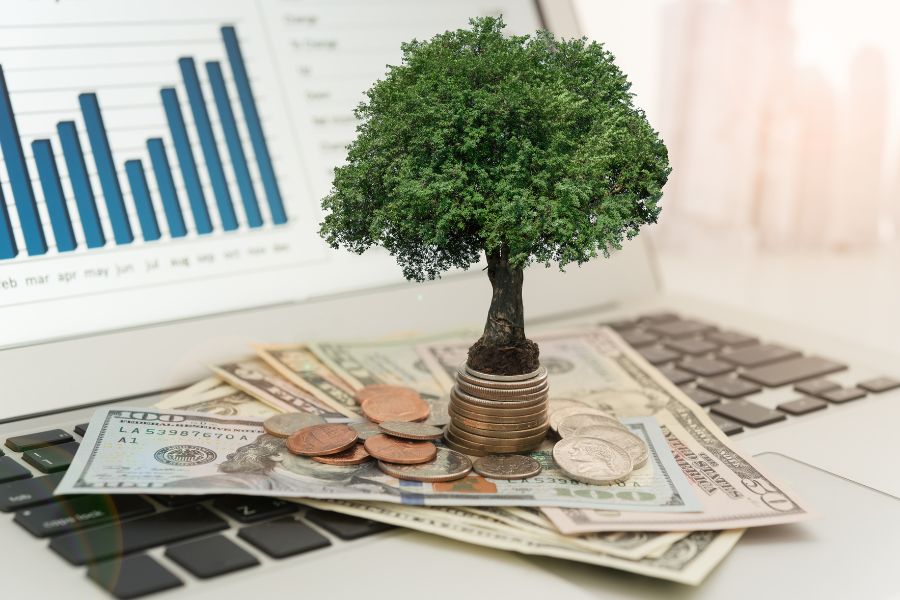Two years ago, I stared at my savings account and wondered why I bothered. The interest was pitiful. I always assumed you needed a fat stack of cash to start investing. Turns out, I was wrong. I decided to jump in with just $50 to see what would happen. After two years of sticking with it, adding a little each month, and reinvesting every dollar, my portfolio grew to over $2,400. Honestly, I still can’t believe it sometimes.

The ride? Far from perfect. I messed up plenty. But starting small let me learn the ropes without risking rent money. What blew my mind was how quickly those tiny deposits started to snowball. Let me walk you through what actually happened, the strategies that paid off, the ones that flopped, and how you can totally do this—even if you’re broke or nervous. If you’ve got $50 or $500, you can use these same tricks to start building real wealth.
Key Takeaways
- You don’t need a fortune. Starting with $50 and adding a bit each month can really turn into thousands, thanks to compounding.
- Reinvesting dividends and sticking with solid, reliable companies helps your money grow—even if you’re starting small.
- The most important thing? Build the habit. Don’t wait for “enough” money. Just start.
Getting Started With a $50 Investment
Honestly, $50 isn’t much. But it got me off the sidelines. I had to figure out the basics, but I didn’t lose sleep over risking it.
I hunted for the right platform and stuck with simple investments. No fancy jargon, no wild speculation.
Why I Chose to Begin With $50
I picked $50 because I could lose it and not panic. It was enough to make me care, but not enough to hurt.
Here’s what that $50 taught me:
- How to open an account (surprisingly easy)
- What fees actually cost you
- How markets bounce around
- Why patience beats panic
Honestly, most people wait and wait. I almost did, too. But I got tired of excuses. That $50 just sat in my checking account anyway.
Starting small also made it easier to experiment. I tried a few different investments to see what worked for me. Those early, low-pressure lessons set me up for bigger moves later.
How I Opened My First Investment Account
I opened my first investment account in less than 15 minutes. All I needed was my Social Security number, bank info, and a little patience.
Here’s what I did:
- Downloaded the app
- Filled in my info
- Linked my bank
- Snapped a quick ID photo
Most apps don’t charge to open an account. I skipped any broker that wanted a big deposit.
The trickiest part? Deciding between a taxable or retirement account. I picked a regular one so I could pull my money out if I needed it.
Some apps approved me instantly. Others took a day. Once my account was open, I tossed in my $50 and got started.
Picking the Right Platform for Small Investments
I checked out a bunch of platforms before settling. Commission-free trading was a must—fees eat up small accounts fast.

Here’s what I looked at:
| Platform | Minimum | Fees | Best For |
|---|---|---|---|
| Robinhood | $0 | $0 trades | Beginners |
| Webull | $0 | $0 trades | Research tools |
| Betterment | $0 | 0.25%/year | Hands-off investing |
Robinhood won me over because it was simple and let me buy fractional shares. With just $50, I could own pieces of big names like Apple.
Fractional shares were a game-changer. I didn’t have to settle for penny stocks or random companies.
I skipped anything with monthly fees or confusing dashboards. I wanted to learn, not get lost or nickel-and-dimed.
Growth Over Two Years: What Actually Happened
My $50 became a real teacher. I saw how time and compounding worked—sometimes slowly, sometimes with a jolt.
Tracking My Portfolio Month by Month
Every month, I checked my portfolio. Watching the numbers go up (and sometimes down) taught me a lot.
The first month? Ouch. My stock dropped 12%. Suddenly, my $50 shrank to $44. I almost quit.
By month six, I was back to $52. Not exactly thrilling, but I felt more confident.
| Month | Portfolio Value | Gain/Loss |
|---|---|---|
| 1 | $44 | -$6 |
| 6 | $52 | +$2 |
| 12 | $61 | +$11 |
| 24 | $73 | +$23 |
Year two was way better. By month 24, I hit $73. That’s a $23 gain—just from the original $50.
Tracking every month helped me chill out during dips and reminded me to add more when I could.
The Power of Time and Compounding
Time became my biggest ally. Compounding started slow, but by the second year, it kicked in. Year one, I earned a 22% return. That sounds wild, but it was just $11 in actual money.

Year two? The returns came from both my original $50 and the $11 from year one. Compounding in action. I made $3.50 in interest just from my first year’s gains. It’s not much, but it’s proof that compounding works—even with pocket change.
Here’s what I learned about compounding:
- Your interest earns its own interest
- The longer you leave it, the better it gets
- Even $50 can grow if you give it time
Turns out, starting early beats waiting for a bigger paycheck.
Rate of Return vs. Interest Rates
Learning about rate of return changed how I thought about investing.
My stock returned 22% in year one. Compare that to a 2.5% savings account. No contest.
Interest rates at banks barely budged while my stock kept climbing.
Over two years, my total return was 46%. My $50 turned into $73 with dividends and growth.
Simple interest would’ve given me $5 a year at 10%. Compounding gave me $23 in the same time.
Breakdown:
- Year 1: 22% ($11 gain)
- Year 2: 19% ($12 gain)
- Total: 46% over two years
Now I always compare rates before choosing where to stash my money.
My Top Strategies for Small Investments
Two things made the biggest difference: adding money regularly and spreading my risk.
Consistent Contributions Make All the Difference
Adding to my account every month mattered way more than my starting amount.

Here’s how I did it:
- Months 1–6: $25 each month
- Months 7–12: $50 each month
- Months 13–24: $75 each month
The magic? Compounding. My early deposits earned returns, then those returns earned more.
I used dollar-cost averaging. When prices dipped, I bought more shares. When prices rose, I bought fewer.
Setting up automatic transfers kept me honest. No temptation to skip a month or blow the cash on takeout.
Diversification and Managing Risk
I didn’t want to gamble everything on one stock. So I split my money across different investments.
Here’s my mix:
- 60% index funds (broad market)
- 20% individual stocks (for growth)
- 15% bonds (for stability)
- 5% REITs (real estate)
Index funds became my safety net. When some stocks tanked, others kept me afloat.
I never put more than 10% in a single company. That rule saved me when one pick dropped 30% in half a year.
Bonds acted differently from stocks. When interest rates went up, bonds dipped—but stocks often kept climbing.
Frequently Asked Questions
Lots of folks ask how to make the most of small investments and avoid rookie mistakes. Here’s what I’ve learned.
Smartest Strategies for Tiny Budgets
Dollar-cost averaging is a lifesaver. I invested $2 to $5 whenever I could, instead of waiting to save big chunks.
Index funds and ETFs give you instant diversification. With one buy, you own a slice of hundreds of companies.
Dividend stocks start paying you right away. I picked Kenvue for its quarterly payouts, then reinvested every cent.
Fractional shares let you own pieces of expensive stocks. No need to buy a whole share if you can’t afford it.
How to Maximize Returns on $50
Reinvest every dividend. My quarterly $6 in dividends went straight back to work, buying more shares.
Stick with companies that have strong fundamentals, not just hype. I chose brands with steady demand.
Avoid trading too often. Every trade chips away at your gains, especially in small accounts.
Use commission-free brokers so you keep more of your money invested.
Biggest Mistakes Beginners Make
Waiting for the “perfect” time just means missing out on compounding. I wish I’d started sooner.
Panic selling during dips kills long-term gains. I held on during rough patches and came out ahead.
Chasing hot tips is just gambling. I did my homework before putting down real money.
Not reinvesting dividends? That’s leaving money on the table. Automatic reinvestment helped my $50 grow way faster.
Best Platforms for Small Investors
Look for zero-commission trades. Fees hurt small investors most.
Fractional share platforms let you buy into expensive stocks for just a few bucks.
Robo-advisors can spread your money across lots of investments and handle rebalancing for you.
Most big brokers now have $0 minimums. You don’t need a fortune to start.
Assessing Risk vs. Reward With Small Investments
Diversify, even with $50. An ETF spreads your money across hundreds of companies.
Time matters more than starting balance. I invested for the long haul, not quick wins.
Blue-chip dividend stocks offer steady returns with less risk. Companies like Kenvue have proven track records.
Only invest what you can afford to lose. I never risked money I needed for bills or groceries.
What Are Some Success Stories of Small Investments Growing Over Time?
Let me tell you about my $50 in Kenvue. I watched it grow to $686.35 in less than a year. I just kept tossing in small amounts—sometimes $2, sometimes $5—until I had 30 shares.
Now, that little investment pays me $24 a year in passive income. The best part? Every quarter, the dividends buy more shares for me automatically.
I’ve seen others do something similar. One investor I know started with just $50 and managed to double it within a year. They stuck with steady investing and always reinvested their earnings.
If you’re curious about building wealth, regular $50 monthly investments can go a long way. Over the years, time and compounding can really work their magic. Isn’t it wild how small, steady steps can add up?



